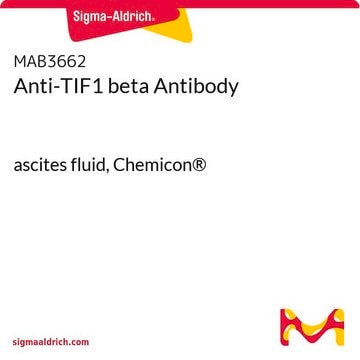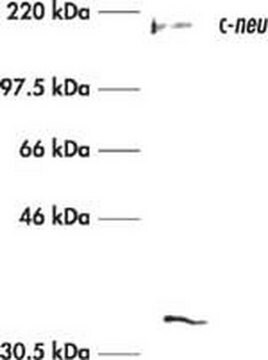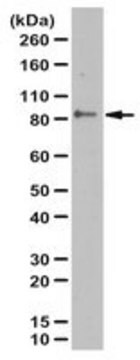ABE1859
Anti-KAP-1/TRIM28 Antibody
serum, from rabbit
Synonym(s):
Transcription intermediary factor 1-beta, TIF1-beta, E3 SUMO-protein ligase TRIM28, KRAB-associated protein 1, KAP-1, KRAB-interacting protein 1, KRIP-1, Nuclear corepressor KAP-1, RING finger protein 96, Tripartite motif-containing protein 28, KAP-1/TRI
About This Item
Recommended Products
biological source
rabbit
Quality Level
antibody form
serum
antibody product type
primary antibodies
clone
polyclonal
species reactivity
mouse, human
technique(s)
immunocytochemistry: suitable
immunoprecipitation (IP): suitable
western blot: suitable
NCBI accession no.
UniProt accession no.
shipped in
dry ice
target post-translational modification
unmodified
Gene Information
mouse ... Trim28(21849)
General description
Kruppel-associated box-/KRAB-associated protein 1 (KAP-1) is a transcriptional co-repressor that selectively targets the KRAB domain of zinc finger protein-based transcription factors with its N-terminal tripartite RBCC (RING, b-box, coiled-coil) domain. KAP-1 uses its C-terminal PxVxL motif and the PHD-Bromo domain to recruit chromatin modifiers, such as heterochromatin protein 1 (HP-1), Histone-lysine N-methyltransferase SETDB1, nucleosome remodeling and deacetylation (NuRD) complex, and histone deacetylases (HDACs), for transcriptional repression. KAP-1 also plays an essential role in the DNA damage response (DDR). Upon DNA damage, KAP-1 is rapidly phosphorylated by Ataxia telangiectasia mutated (ATM) on Ser824, causing chromatin relaxation to facilitate DNA repair. In addition, SIRT1-mediated KAP-1 deacetylation is reported to stabilize KAP1 and 53BP1 interaction, resulting in an enhancement of NHEJ-mediated repair efficiency in a KAP-1 pSer824-independent manner.
Specificity
Immunogen
Application
Epigenetics & Nuclear Function
Nuclear Receptors
Western Blotting Analysis: A representative lot detected similar level of endogenous KAP-1/Trim28 in HEK293T cells regardless of ionizing radiation treatment or shRNA-mediated SirT1 downregulation (Lin, Y.H., et al. (2015). PLoS One. 10(4):e0123935).
Western Blotting Analysis: A representative lot detected KAP-1/Trim28 in whole cell lysates, but not in BAP1, FoxK1, or FoxK2 immunoprecipitate (Okino, Y., et al. (2015). J. Biol. Chem. 16;290(3):1580-1591).
Immunoprecipitation Analysis: 10 µL from a representative lot immunoprecipitated KAP-1/Trim28 from HEK293T cell lysates (Courtesy of Dr. Zhenkun Lou, Mayo clinic, Rochester, MN).
Immunocytochemistry Analysis: An 1:1000 dilution from a representative lot detected KAP-1/Trim28 nuclear localization in U2OS cells (Courtesy of Dr. Zhenkun Lou, Mayo clinic, Rochester, MN).
Immunoprecipitation Analysis: A representative lot co-immunoprecipitated SirT1 with KAP-1/Trim28 from HEK293T cell lysates (Lin, Y.H., et al. (2015). PLoS One. 10(4):e0123935).
Western Blotting Analysis: An 1:1000 dilution from a representative lot detected KAP-1/Trim28 in mouse embryonic fibroblast (MEF) lysate, as well as downregulated KAP-1/Trim28 in lysates from KAP1 siRNA-treated HEK293T cells (Courtesy of Dr. Zhenkun Lou, Mayo clinic, Rochester, MN).
Quality
Western Blotting Analysis: A 1:2,000 dilution of this antibody detected KAP-1/TRIM28 in 10 µg of HEK293T cell lysate.
Target description
Physical form
Storage and Stability
Handling Recommendations: Upon receipt and prior to removing the cap, centrifuge the vial and gently mix the solution. Aliquot into microcentrifuge tubes and store at -20°C. Avoid repeated freeze/thaw cycles, which may damage IgG and affect product performance.
Other Notes
Disclaimer
Not finding the right product?
Try our Product Selector Tool.
Storage Class Code
12 - Non Combustible Liquids
WGK
WGK 1
Flash Point(F)
Not applicable
Flash Point(C)
Not applicable
Regulatory Listings
Regulatory Listings are mainly provided for chemical products. Only limited information can be provided here for non-chemical products. No entry means none of the components are listed. It is the user’s obligation to ensure the safe and legal use of the product.
JAN Code
ABE1859:
Certificates of Analysis (COA)
Search for Certificates of Analysis (COA) by entering the products Lot/Batch Number. Lot and Batch Numbers can be found on a product’s label following the words ‘Lot’ or ‘Batch’.
Already Own This Product?
Find documentation for the products that you have recently purchased in the Document Library.
Our team of scientists has experience in all areas of research including Life Science, Material Science, Chemical Synthesis, Chromatography, Analytical and many others.
Contact Technical Service







